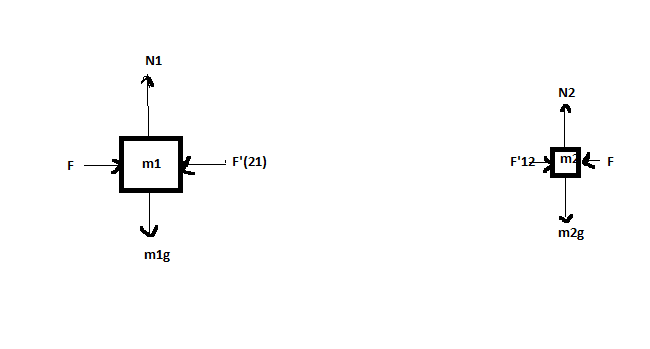Question 2. A force F acts on two blocks as shown. Mz (a) What is the acceleration of each block? (b) What is the force m1 exerts on m2? (c) Let the same force act from the right. What is the acceleration of the blocks? (d) Again let the same force act from the right. What is the force m2 exerts on m1? Is this answer the same as your answer from part (b)? Why or why not?
Question 2. A force F acts on two blocks as shown. Mz (a) What is the acceleration of each block? (b) What is the force m1 exerts on m2? (c) Let the same force act from the right. What is the acceleration of the blocks? (d) Again let the same force act from the right. What is the force m2 exerts on m1? Is this answer the same as your answer from part (b)? Why or why not?
College Physics
11th Edition
ISBN:9781305952300
Author:Raymond A. Serway, Chris Vuille
Publisher:Raymond A. Serway, Chris Vuille
Chapter1: Units, Trigonometry. And Vectors
Section: Chapter Questions
Problem 1CQ: Estimate the order of magnitude of the length, in meters, of each of the following; (a) a mouse, (b)...
Related questions
Question
Please only answer part D

Transcribed Image Text:4:11 PM Thu Feb 11
* 79%
Dynamics_2 -
5
T
Question 2.
A force F acts on two blocks as shown.
(a) What is the acceleration of each block?
(b) What is the force mi exerts on m2?
(c) Let the same force act from the right. What is the acceleration of the blocks?
(d) Again let the same force act from the right. What is the force m2 exerts on m? Is this answer the
same as your answer from part (b)? Why or why not?
a) F=ma
Since both
the
boxes
F =(m, +m,) a
m).
are connected
with
cach other
thus the masses
be
a = (m, tm)
will
added
Since both
the blocks
are
F=m, = m
2
connected with each o ther
SO
the force
applied on these blocks
are
Same
since the magnit ude of both
the forces are same
m,
F
thus
both the
s boxes will remain
Steady
4 of 6
It

Transcribed Image Text:Question 2.
A force F acts on two blocks as shown.
M2
(a) What is the acceleration of each block?
(b) What is the force m1 exerts on m2?
(c) Let the same force act from the right. What is the acceleration of the blocks?
(d) Again let the same force act from the right. What is the force m2 exerts on m1? Is this answer the
same as your answer from part (b)? Why or why not?
Expert Solution
Step 1
(D)

Step by step
Solved in 2 steps with 1 images

Knowledge Booster
Learn more about
Need a deep-dive on the concept behind this application? Look no further. Learn more about this topic, physics and related others by exploring similar questions and additional content below.Recommended textbooks for you

College Physics
Physics
ISBN:
9781305952300
Author:
Raymond A. Serway, Chris Vuille
Publisher:
Cengage Learning

University Physics (14th Edition)
Physics
ISBN:
9780133969290
Author:
Hugh D. Young, Roger A. Freedman
Publisher:
PEARSON

Introduction To Quantum Mechanics
Physics
ISBN:
9781107189638
Author:
Griffiths, David J., Schroeter, Darrell F.
Publisher:
Cambridge University Press

College Physics
Physics
ISBN:
9781305952300
Author:
Raymond A. Serway, Chris Vuille
Publisher:
Cengage Learning

University Physics (14th Edition)
Physics
ISBN:
9780133969290
Author:
Hugh D. Young, Roger A. Freedman
Publisher:
PEARSON

Introduction To Quantum Mechanics
Physics
ISBN:
9781107189638
Author:
Griffiths, David J., Schroeter, Darrell F.
Publisher:
Cambridge University Press

Physics for Scientists and Engineers
Physics
ISBN:
9781337553278
Author:
Raymond A. Serway, John W. Jewett
Publisher:
Cengage Learning

Lecture- Tutorials for Introductory Astronomy
Physics
ISBN:
9780321820464
Author:
Edward E. Prather, Tim P. Slater, Jeff P. Adams, Gina Brissenden
Publisher:
Addison-Wesley

College Physics: A Strategic Approach (4th Editio…
Physics
ISBN:
9780134609034
Author:
Randall D. Knight (Professor Emeritus), Brian Jones, Stuart Field
Publisher:
PEARSON